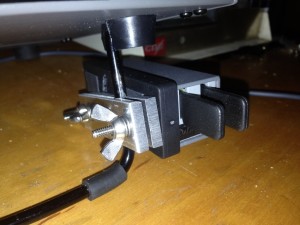 Making the Palm Mini Paddle Stay Put
Making the Palm Mini Paddle Stay Put
In my on-going quest to produce a lightweight yet good-performing kit of portable equipment to carry along on my exotic work travels, I set my sights once again upon the Morse keying paddles. When I was a student, I carried what I had: a black-base Bencher BY-1. This caught the attention of nearly every airport security screener and was obviously quite heavy, but it stayed put on the table (for the most part) when I aggressively worked a pileup. A few years back, my wonderful, loving, and patient wife, solicited suggestions for Christmas gifts and I suggested a Palm Radio Mini Paddle. (She’s grateful when I provide a link to a web site with a shopping cart in these situations.)
The Palm is really a joy to use and is extraordinarily lightweight, which is perfect for travel. However, I’ve always struggled with how to keep it steady on a table. I have the magnetic base, but that presupposes a ferromagnetic surface to which it will mount. Since both the Elecraft K3 and K2 have aluminum panels, I can’t count on the radio. I tried a variety of additional things, up to and including, trying to design a 3D-printed carrier that is akin to the Begali Traveler. So, I shelved the project, only using the Palm key for casual portable operating when mass trumped long-term operating comfort and efficiency. Good fortune happened upon me and I built this.
When I decided to add an amplifier (more on this in the future) to my portable setup, again pressure set in on the mass of everything. So, I revisited the Palm Mini project. I had purchased a number of mounting clips for the key (hedging my bets against the ephemeral nature of ham radio businesses); so, I set out to attach one to the K2. I’d seen the photo of the base attached to the right-hand side panel of the K2 by the power switch. But, I really didn’t want to drill holes in the panel, plus that puts the paddles too high when the tilt bail is raised (which is necessary to see the display).
So, I fabricated two strips of 3/16-inch aluminum plate (leftover from the hexagonal beam I built a few years ago) with a hole bored down between them to clamp on the tilt bail of the K2 or the K3. There’s nothing particularly critical about the construction of it, although I used a Bridgeport mill to do all the cutting; you might be able to do it in a drill press. I think I ended up with a #14 drill for the clamp hole. I used 6-32 hardware because I had it on-hand and I like the bigger stuff. I had to enlarge the adjustment slot in the Palm base to handle the bigger diameter.














Don’t know how to add a photo here but a tin sheet fastened to the side of my kx1 with double face tape holds my paddles nicely
you wouldn’t even know its there when the paddles are not attached.
Great idea! I’m afraid that probably wouldn’t stay put for me, though… I might try to dig out a piece of steel and try it, though…
Great idea